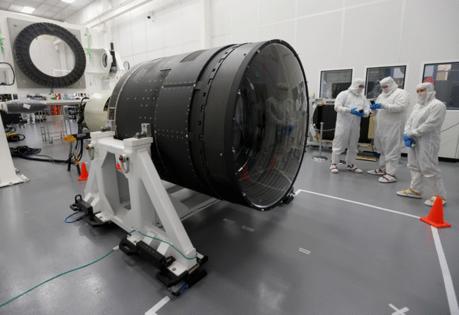World's largest camera, costly, fragile and built in California, makes epic journey to South American mountaintop
Published in Home and Consumer News
The world’s biggest camera was on its way from its birthplace at SLAC National Accelerator Laboratory in Menlo Park, California, to a mountaintop half a hemisphere away in the foothills of the Andes. But there was a problem. And it required an order from Chile’s President Gabriel Boric to solve.
“This was very high stakes operation. It’s the future of U.S. astronomy,” said SLAC engineer and camera project manager Travis Lange. “There are literally thousands of people that are planning on using the data.”
In addition to its famous linear accelerator which is used to find the tiniest particles in the universe, and now the massive camera, SLAC is known for building large, sophisticated machines using X-rays, lasers, and electron beams to untangle enigmas on earth and in the cosmos.
Most of the monumental trip had gone smoothly for the $168 million instrument, which will provide never-before-seen views into outer space and allow groundbreaking astronomical research from its perch in the specially built Rubin Observatory atop the Cerro Pachón ridge in Chile.
Its slow, before-dawn journey began May 14 in a shipping container on a flatbed truck that traveled from SLAC up Highway 280, then down to San Francisco International Airport. Within a few hours the container holding the 5 1/2-foot tall, 10-foot long, 6,250-pound camera was safely fastened to the floor of a chartered 747 cargo jet, along with two additional containers and dozens of crates holding its associated equipment.
The nearly 11-hour flight to Santiago, Chile also went well, said Lange and fellow SLAC engineer Margaux Lopez, who were tasked with leading the operation to pack up and ship the device to the observatory.
But they didn’t plan on striking truckers blocking highways around Santiago, the nation’s capital, in protests that threatened to throw a giant logistical wrench into the transportation mission.
It is a testament to the importance of the camera to science that Chile’s Interior Minister Carolina Tohá Morales took the call about the blockade from an official with the Association of Universities for Research in Astronomy, and then called Boric, who ordered a police escort so the camera could get through.
There were a few hitches as the nine-truck camera convoy wound its way for more than six hours up a 22-mile gravel road to Cerro Pachón at about 8,900 foot elevation in the Andes foothills — notably a loss of traction by the vehicle carrying the camera container — but it arrived safely mid-day May 16.
On Tuesday, Lopez, who had been working on the transportation plan since 2018, pronounced herself “very relieved” and “also proud.” As soon as she had learned of the strike, and a separate labor action involving equipment handlers at the Santiago airport, she created five different scenarios to address the issues.
“While there were some hiccups we were able to resolve all of the things that happened,” Lopez said via video from the observatory in Chile. “Things mostly happened according to plan, which is pretty impressive.”
Sending the hugely expensive and important Legacy Survey of Space and Time camera, with its 189 fragile light sensors, five delicate filters and assorted complex electronics by road, air, and then road again, put a heavy weight on Lopez and Lange.
“It’s a little bit like sending your kid off to college,” Lange said. “It’s wonderful and terrifying at the same time.”
At the Rubin Observatory the camera ]will be bolted onto the end of a huge telescope, probably in October or November, Lange said. Once installation and setup is complete, it will shoot photos of 20 billion galaxies to be stitched together in expansive panoramas providing astronomers with ever-changing vistas onto colliding and exploding stars, asteroids, and mysterious interstellar phenomena including dark energy and dark matter.
Given the value of the instrument and its importance to science, SLAC had kept the transport mission shrouded in secrecy, refusing to specify when the camera would leave for the San Francisco airport.
“I like to think that there are not bad actors who would sabotage something like this, but it’s not difficult for us to not advertise that it’s going out the door,” Lange said earlier.
Building the camera required a facility with air 1,000 times cleaner than an average indoor space, to prevent dust and other materials from landing on the highly sensitive outer lens and degrading its quality, or from getting into the device’s inner workings.
Engineers custom built a sealed clean room with a 24-foot ceiling, and anyone entering had to don head-to-toe white bunny suits and blue latex gloves, lending day-to-day activities the ambience of a crime scene.
Before shipment, the device was wrapped in a giant silver plastic bag and looked “like a burrito,” Lopez said. Because moisture is an enemy of the instrument, into the bag went dozens of bags of moisture-grabbing desiccant, each the size of a small pillow and weighing several pounds — industrial-sized versions of the tiny packs that come with many consumer electronics products.
The camera was bolted onto a 4,000-pound yellow steel frame, then lifted up and lowered into a pristine steel shipping container, where the frame was fitted with sensors to measure and track impacts to the camera from bumps and jarring — which post-trip data showed were minimal.
Chief among Lange’s pre-shipment impact worries were the camera’s 189 custom-made silicon sensors, set a couple hairs’ width apart and costing $150,000 each.
“It doesn’t take very much motion for that distance to be closed,” Lange said earlier. “If they contact, they break. It would be pretty bad.”
Earlier, to help make sure the transport apparatus could keep the camera safe on its journey to Chile, a dummy version of the device, heavily weighted with black iron gym plates and hooked up with impact sensors, was put on a truck and driven around the Bay Area.
“We sent the driver on an eight-hour drive and said, ‘Find all the worst roads that you can. Hit 101. Hit 880,'” Lange said. “We were logging the shocks during that process.”
Then they did a much longer test run: by truck to Miami, then on a plane to Chile and up to the observatory site and back to Menlo Park.
Now the camera waits in its new clean room on the third level of the eight-level observatory. On installation day, the instrument will travel in a giant elevator five levels up to the facility’s dome, and technicians will use 108 large, high-strength bolts to attach it to the tip of the telescope.
Five months of testing will follow. If all goes well, the first light photons will enter the camera in the spring.
The camera and telescope, Lange said, are “going to revolutionize astronomy.”
©#YR@ MediaNews Group, Inc. Visit at mercurynews.com. Distributed by Tribune Content Agency, LLC.







Comments